



Army Watercraft
Army Watercraft provide the foundation for theater opening and reception of Army and joint forces committed in advancing the national military strategy and are an integral part of Force XXI for projecting and sustaining combat power. Waterborne logistics delivers 90 percent of all unit equipment and supplies of U.S. forces. Army watercraft - lighterage and floating utility craft (landing craft, amphibians, modular causeways and harbor craft) - provide the critical link between offshore arrival of combat power loaded aboard strategic sealift ships and placing that power
ashore in a ready-to- fight configuration. Terminal operations and water transport, which includes strategic sealift
and the logistic support provided by Army watercraft, are essential to
projecting and sustaining forces engaged in a range of military opera-tions
worldwide. While strategic sealift delivers over 95 percent of the tonnage required by operating military forces, Army watercraft become the critical link when that
tonnage is projected over the shore, through fixed ports not accessible to deep-draft vessels, or through fixed ports not adequate without the use of
watercraft (all classified as LOTS operations). Army watercraft units execute all functions required for successful theater opening, reception, and sustainment
of the deployed force.
A proper mix of Army watercraft must be pre-positioned
for availability during the early phases of
force closure. Army watercraft can be prepositioned
on FLOFLO ships, SEABEEs, and/or on the decks of
other large vessels.
Traditionally, Logistics Over-the-Shore [LOTS] has been defined as operations
wherein a vessel anchored in open water was discharged into lighters, with the cargo subsequently discharged over a bare beach. The current definition of LOTS encompasses not only the capability to provide initial sustainment for early
entry forces over an unimproved beach, but also the following:
- Discharge through major or minor ports
inaccessible or denied to deep-draft shipping.
- Intratheater sealift of cargo and equipment.
- Support of normal fixed port operations (i.e.,
berthing ships, providing heavy lift floating crane
service, shuttling LASHs).
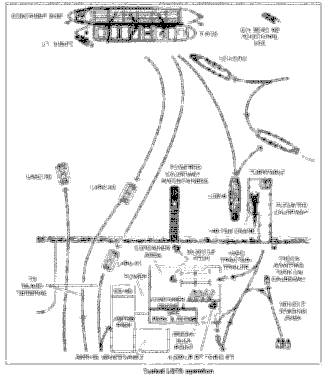 A LOTS operation may be conducted as part of the base, garrison, or theater development that immediately follows an amphibious operation or as a
separate evolution when no amphibious operation precedes it. During LOTS operations,
supplies and equipment are moved ashore and transferred to a transportation agency for onward movement. Because LOTS operations are inherently dangerous, risk assessment and risk management are ongoing requirements.
Certain conditions require a LOTS operation through
major or secondary ports. If, for example, port facilities are denied to deep-draft shipping as a result of enemy action, a LOTS operation would be the alternative. Other circumstances requiring LOTS include inadequate port berthing capability
or inadequate port facilities due to shallow water depths and/or enemy action.
LOTS operations across a bare beach are the most resource-demanding
in terms of the type and number of watercraft required. In many areas, the capacities of existing ports are not adequate to support theater tonnage
requirements. This factor, along with the possibility of enemy insurgent activities, requires that plans favor widely scattered beach operations over large port complexes. In-the-stream anchor is an operation where a deep-draft vessel is anchored in protected deep waters, such as a harbor. Offshore anchor provides anchorage off the shoreline in unprotected deep water. From either of these anchorages, ships can discharge to lighters for subsequent discharge to a fixed-port facility, unimproved facility, or bare beach. Nearly 40 percent of all cargo entering a theater by surface means is delivered through dispersed beach terminals. Therefore, the theater�s senior terminal commander must continually plan for and open new beaches. These sites accommodate increased tonnages and replace the tonnage capacity of a port or unimproved facility that has been made untenable by enemy actions.
A LOTS operation may be conducted as part of the base, garrison, or theater development that immediately follows an amphibious operation or as a
separate evolution when no amphibious operation precedes it. During LOTS operations,
supplies and equipment are moved ashore and transferred to a transportation agency for onward movement. Because LOTS operations are inherently dangerous, risk assessment and risk management are ongoing requirements.
Certain conditions require a LOTS operation through
major or secondary ports. If, for example, port facilities are denied to deep-draft shipping as a result of enemy action, a LOTS operation would be the alternative. Other circumstances requiring LOTS include inadequate port berthing capability
or inadequate port facilities due to shallow water depths and/or enemy action.
LOTS operations across a bare beach are the most resource-demanding
in terms of the type and number of watercraft required. In many areas, the capacities of existing ports are not adequate to support theater tonnage
requirements. This factor, along with the possibility of enemy insurgent activities, requires that plans favor widely scattered beach operations over large port complexes. In-the-stream anchor is an operation where a deep-draft vessel is anchored in protected deep waters, such as a harbor. Offshore anchor provides anchorage off the shoreline in unprotected deep water. From either of these anchorages, ships can discharge to lighters for subsequent discharge to a fixed-port facility, unimproved facility, or bare beach. Nearly 40 percent of all cargo entering a theater by surface means is delivered through dispersed beach terminals. Therefore, the theater�s senior terminal commander must continually plan for and open new beaches. These sites accommodate increased tonnages and replace the tonnage capacity of a port or unimproved facility that has been made untenable by enemy actions.
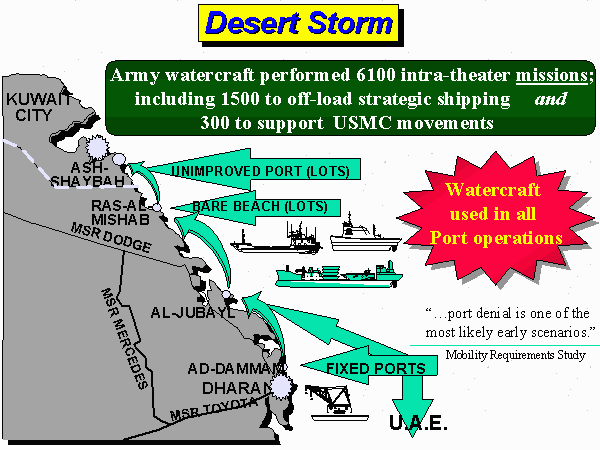 Watercraft fall into two categories, lighterage and floating utility. These two categories are defined according to the mission they perform.
Watercraft fall into two categories, lighterage and floating utility. These two categories are defined according to the mission they perform.
- Lighterage are craft used to transport equipment, cargo and personnel between ships, from ship-to-shore or
for intratheater transport. Lighterage are further classified into conventional displacement (landing craft),
amphibious (wheeled), or modular causeway systems (powered ferry).
- Floating Utility craft perform operations incidental to water terminal operations, except lighterage service.
Watercraft in this category are harbor and ocean going tugs, pusher tugs, floating cranes, barges, floating machine
shops, floating causeway and Roll-On/Roll-Off (RO/RO) discharge facilities (RRDF).
Each vessel in the Army�s marine fleet bears an
individual serial number, preceded by an applicable
prefix. Vessel prefixes are as follows:
- Barge, dry-cargo, 1 nonpropelled, medium (100 through 149 feet) � BC
- Conversion kit, barge deck enclosure � BCDK
- Barge, dry-cargo nonpropelled, large (160 feet and over) � BCL
- Crane, floating � BD
- Lighter, beach discharge � BDL
- Barge, liquid cargo, nonpropelled � BG
- Barge, dry cargo, nonpropelled � BK
- Barge, pier, nonpropelled � BPL
- Barge, refrigerated, nonpropelled � BR
- Ferryboat � FB
- Dry dock, floating � FD
- Repair shop, floating, marine craft, nonpropelled � FMS
- Freight and supply vessel large (140 feet and over) � FS
- Boat, utility � J
- Lighter, amphibious � LARC
- Landing craft, mechanized � LCM
- Landing craft, utility � LCU
- Logistics support vessel � LSV
- Tug, large, seagoing � LT
- Tug, small, harbor � ST
- Boat, passenger and cargo � T
- Temporary crane discharge facility � TCDF
- Vessel, liquid cargo � Y
Landing craft mechanized-8.
The LCM-8 transports
cargo, troops, and vehicles from ship to shore or in
retrograde movements. It is also used in lighter and
utility work in harbors. The LCM-8 is designed for
use in rough or exposed waters and can be operated
through breakers and grounded on the beach. The bow
ramp allows RORO operations with wheeled and
tracked vehicles. Its small size allows for use in
confined areas.
The LCM-8 can be transported by LSVs, LCU
2000s, LSTs, commercial bulk carriers, and heavy
lift ships. Characteristics and capabilities include
the following:
- Length overall: 74 feet.
- Beam: 21 feet.
- Displacement (weight): 58 LTONs (light);
111 LTONs (loaded).
- Deck area: 620 square feet.
- Payload: 53 tons.
- Range: 332 nautical miles at 11 knots (light);
271 nautical miles at 9 knots (loaded).
- Draft: 3.5 feet (light); 5 feet (loaded).
Lighter, amphibious, resupply, cargo, 60-ton.
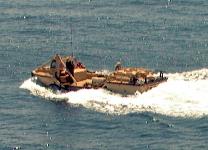
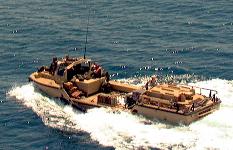 The LARC-60 transports wheeled and tracked
vehicles, including beach preparation equipment and
general cargo from ship to shore or to inland transfer
points. It is the only amphibian in the Army inventory,
and the only vessel capable of landing on a beach
through a breaking surf. The LARC-60 can be deck-loaded
on a commercial vessel or heavy lift ship for
transport overseas. It can be transported on a semi-submersible
vessel, in the well deck of an LSD, or
aboard a SEABEE. Characteristics and capabilities
include the following:
The LARC-60 transports wheeled and tracked
vehicles, including beach preparation equipment and
general cargo from ship to shore or to inland transfer
points. It is the only amphibian in the Army inventory,
and the only vessel capable of landing on a beach
through a breaking surf. The LARC-60 can be deck-loaded
on a commercial vessel or heavy lift ship for
transport overseas. It can be transported on a semi-submersible
vessel, in the well deck of an LSD, or
aboard a SEABEE. Characteristics and capabilities
include the following:
- Length overall: 63 feet.
- Beam: 27 feet.
- Displacement (weight): 88 LTONs (light).
- Deck area: 527 square feet.
- Payload: 60 tons.
- Range: land, 60-ton load, 150 statue miles at
14 MPH; water, 60-ton load, 75 nautical miles at
6 knots.
- Draft: 7.5 feet (light); 9 feet (loaded).
Landing craft, utility, 1600 class.
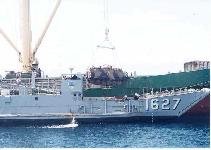 The LCU-1600
transports wheeled and tracked equipment and gen-eral
cargo from ship to shore, shore to shore, and in
retrograde operations. RORO missions are accom-plished
using the vessel�s bow and stern ramps. It is
valuable in LOTS operations and intratheater trans-port
using harbor and IWW routes. The LCU-1600
is not capable of self-deployment over open oceans.
It is deployed aboard vessels such as HLPSs, barges,
and FLOFLO ships. It can also be loaded on Navy
LSTs, LSDs, or commercial bulk carriers. Charac-teristics
and capabilities include:
The LCU-1600
transports wheeled and tracked equipment and gen-eral
cargo from ship to shore, shore to shore, and in
retrograde operations. RORO missions are accom-plished
using the vessel�s bow and stern ramps. It is
valuable in LOTS operations and intratheater trans-port
using harbor and IWW routes. The LCU-1600
is not capable of self-deployment over open oceans.
It is deployed aboard vessels such as HLPSs, barges,
and FLOFLO ships. It can also be loaded on Navy
LSTs, LSDs, or commercial bulk carriers. Charac-teristics
and capabilities include:
- Length overall: 135 feet.
- Beam: 30 feet.
- Displacement (weight): 205 LTONs (light);
390 LTONs (loaded).
- Deck area: 1,785 square feet.
- Payload: 184 tons.
- Range: 1,200 nautical miles at 12 knots (light);
1,100 nautical miles at 11 knots (loaded).
- Draft: 6 feet (light); 7 feet (loaded).
Small tug, 65-foot.
The 65-foot tug moves non-propelled
barges in harbors and IWWs. Secondary
functions include general utility uses, fire fighting,
salvage, and assisting in the docking and undock-ing
of large vessels. Overseas deployment is by
deck loading aboard a heavy lift ship or by towing
by a larger vessel. Characteristics and capabilities
include:
- Length overall: 71 feet.
- Beam: 19.5 feet.
- Displacement (weight): 100 LTONs (light);
122 LTONs (loaded).
- Bollard pull: 8.75 tons.
- Range: 1,700 nautical miles at 12 knots (light);
variable with tow (loaded).
- Draft: 7.5 feet (light); 8.5 feet (loaded).
Large tug, 100-foot.
The 100-foot tug is used to
berth and unberth large oceangoing vessels and for
heavy towing within harbor areas. Secondary func-tions
include general utility uses, fire fighting, and
salvage operations. It may also be used for limited
off-shore towing between terminals. Depending
upon distance, weather, sea conditions, and crew
training, the 100-foot tug can self-deploy or be
transported by FLOFLO. Characteristics and capa-bilities
include:
- Length overall: 107 feet.
- Beam: 27 feet.
- Displacement (weight): 295 LTONs (light);
390 LTONs (loaded).
- Bollard pull: 13.8 LTONs/31.5 LTONs.
- Range: 3,323 nautical miles at 12.8 knots/
2,245 nautical miles at 12.8 knots (light); variable
with tow (loaded). NOTE: Higher fuel consumption
of larger engines in ESP tugs reduces range.
- Draft: 11.5 feet (light); 12.5 feet (loaded).
Floating machine shop.
The FMS consists of 14 re-pair
shops, an onboard 9-LTON crane, and an
internal monorail trolley system. The shops are bat-tery,
blacksmith, carpentry, electrical, engine, fuel
injection, machine, sheet metal, paint, pipe fitting,
radar and radio, refrigeration, shop fitting, and
welding. The FMS can accomplish DS/GS level
maintenance, repair, rebuild, and overhaul. The FMS
can support the sustainment phase of operations. It
is not self-propelled; therefore, it must be towed to
overseas locations. Characteristics and capabilities of
the FMS include:
- Length overall: 210 feet.
- Beam: 40 feet.
- Displacement (weight): 1,160 LTONs (light);
1,525 LTONs (loaded).
- Draft: 6 feet (light); 8 feet (loaded).
Crane, barge, 89-ton.
The BD 89T is used
to load and discharge heavy lift cargo that is
beyond the capacity of ship�s gear. It is com-monly
called the 100-ton crane which is the short
ton capacity rating. The BD 89T is not
self-propelled; it can be towed overseas or
deck-loaded aboard a semi-submersible ship for
transport. Its characteristics and capabilities
include:
- Length overall: 140 feet.
- Beam: 70 feet.
- Displacement (weight): 1,630 (loaded).
- Boom length: 123.5 feet.
- Capacity: 89 LTONs at 80-foot radius.
- Draft: 6.3 feet (loaded).
Barge, deck or liquid cargo, BG 231C (fuel).
The BG 231 transports liquid or general cargo in
harbors and inland waters. It can transfer liquid
products from off-shore tankers to shore facilities.
The BG 231 can also serve as a refueling point for
watercraft operating in the area. The barge is
equipped with two skegs aft; this improves its
towing capability by helping to keep it tracking on
course. It can be towed overseas or deck-loaded
aboard an HLPS. Characteristics and capa-bilities
include:
- Length overall: 120 feet.
- Beam: 33 feet.
- Displacement (weight): 185 LTONs (light);
763 LTONs (loaded).
- Cargo capacity: deck, 578 LTONs; liquid,
4,160 barrels (188,416 gallons).
- Cargo pump capacity: 1,050 gallons per minute.
- Draft: 3 feet (light); 9 feet (loaded).
Barge, deck cargo, BC 231A.
The BC 231 trans-ports
containers, general cargo, and wheeled and
tracked vehicles in harbors and IWWs. It is particu-larly
suited for transporting tracked and wheeled
vehicles. It is equipped with two skegs aft, thereby
improving its towing capability by helping to keep it
tracking on course. The BC 231 can be loaded aboard
ships or towed overseas. Characteristics and capa-bilities
include:
- Length overall: 120 feet.
- Beam: 33 feet
- Displacement (weight): 175 LTONs (light);
760 LTONs (loaded).
- Cargo capacity: 585 LTONs.
- Draft: 2.5 feet (light); 8 feet (loaded).
Barge, deck cargo, BC 7005.
The BC 7005 trans-ports
containers, general cargo, and wheeled and
tracked vehicles in harbors and IWWs. Because of its
flush deck without fore and aft sheer, it is particu-larly
suited for transporting vehicles. The BC 7005
was built without skegs, making it easy to maneuver
at port terminals where piers are in close proximity.
The BC 7005 can be deck-loaded aboard ships or
towed overseas. Characteristics and capabilities
include:
- Length overall: 110 feet.
- Beam: 32 feet.
- Displacement (weight): 120 LTONs (light);
690 LTONs (loaded).
- Cargo capacity: 570 LTONs.
- Draft: 1.75 feet (light); 7.5 feet (loaded).
Landing craft, utility 2000.
The LCU 2000 ) transports rolling and tracked
vehicles, containers, and outsized and general
cargo from ships offshore to shore (LOTS), as
well as to areas that cannot be reached by
oceangoing vessels (coastal, harbor, and IWWs). It
can be self-deployed or transported aboard a
FLOFLO vessel. It is classed by the ABS for
full ocean service and one-man engine room
operations and is built to USCG standards. The
LCU 2000 succeeds the 1646 Class LCU and
replaces the 1466 Class in both the Army�s
Active and Reserve inventories. The Army has
35 LCU 2000s. Characteristics and capabilities
of the LCU 2000 include:
- Length (overall): 174 feet.
- Beam: 42 feet.
- Displacement: 575 LTONs (light); 1,087 LTONs
(loaded).
- Deck area: 2,500 square feet (5 M1 main
battle tanks or 12 [24 double-stacked] 20-foot
ISO containers.
- Bow ramp: 16 feet wide x 22 feet long.
- Payload: 350 STONs (15 C-141 loads).
- Range: 10,000 nautical miles at 12 knots (light);
6,500 nautical miles at 10 knots (loaded).
- Draft: 8 feet (light); 9 feet (loaded).
- Beaching draft: 4 feet at the bow.
- Carries up to thirty 20-foot containers or twelve
40-foot containers.
- Sustains crew of 2 warrant officers and 11 en-listed
personnel for up to 18 days.
- Equipped with latest navigation, communica-tions,
and electronic equipment including an automatic
pilot and steering system.
Logistics support vessel.

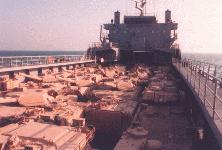
 The LSV provides worldwide transport of general and
vehicular cargo. LSV missions include intratheater
line-haul in support of unit deployment or relocation;
tactical and sustained resupply to remote, undevel-oped
areas along coastlines and on IWWs; and
support to the discharge and backload of ships in
RORO or LOTS operations. Six LSVs are in the
Army inventory. LSV characteristics and capabilities
include:
The LSV provides worldwide transport of general and
vehicular cargo. LSV missions include intratheater
line-haul in support of unit deployment or relocation;
tactical and sustained resupply to remote, undevel-oped
areas along coastlines and on IWWs; and
support to the discharge and backload of ships in
RORO or LOTS operations. Six LSVs are in the
Army inventory. LSV characteristics and capabilities
include:
- Length (overall): 273 feet.
- Beam (molded): 60 feet.
- Displacement (weight): 4,199 LTONs.
- Deck area: 10,500 square feet (21 to 24 M1 main
battle tanks or 25 [50 double-stacked] 20-foot ISO
containers).
- Bow ramp opening: 26 feet wide.
- Payload: 2,000 STONs (86 C-141 loads).
- Range: 8,200 nautical miles at 12.5 knots (light);
6,500 nautical miles at 11.5 knots (loaded).
- Draft: 6 feet (light); 12 feet (loaded).
- Drive-through capability (bow and stem ramps).
- Self-delivery range: 6,500 nautical miles.
- Sustains crew of 6 officers and 23 enlisted per-sonnel
for up to 30 days.
- Transports heavy, outsized cargo including
rolling stock, general cargo, and ISO containers.
Large tug, 128-foot.
The 128-foot LT ) is designed for ocean and coastal
towing operations. All six LTs were fielded in 1994.
LT missions include: assisting bulk and special cargo
ships to berth or anchorage; shuttling non-self
propelled barges and other floating equipment from
location to location during LOTS operations; and
providing ocean, coastal, and inland waterway
tow service for Army logistic support. The LT is
self-deployable worldwide. Characteristics and capabilities
include:
- Length overall: 128 feet.
- Beam (molded): 36 feet.
- Displacement (weight): 786 LTONs (light);
1,057 LTONs (loaded).
- Bollard pull: 58 tons.
- Range: 5,000 nautical miles at 13.5 knots (light);
5,000 nautical miles at 12 knots (loaded).
- Draft: 14.5 feet (light); 17 feet (loaded).
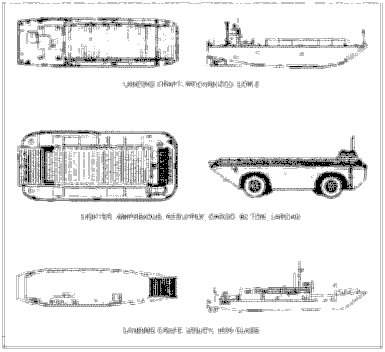
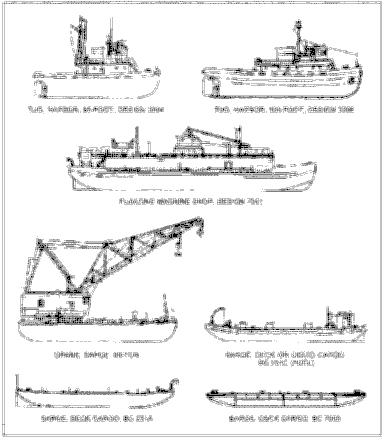
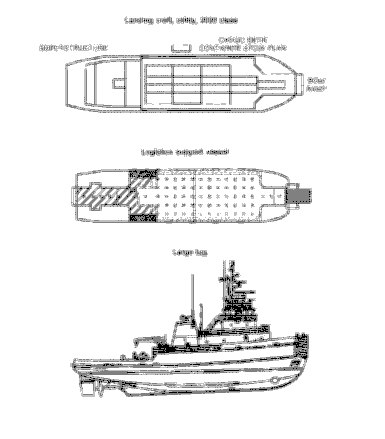
Sources and Resources
http://www.fas.org/man/dod-101/sys/ship/army.htm
Maintained by Robert Sherman
Originally created by John Pike
Updated Saturday, February 12, 2000 2:48:42 PM





 A LOTS operation may be conducted as part of the base, garrison, or theater development that immediately follows an amphibious operation or as a
separate evolution when no amphibious operation precedes it. During LOTS operations,
supplies and equipment are moved ashore and transferred to a transportation agency for onward movement. Because LOTS operations are inherently dangerous, risk assessment and risk management are ongoing requirements.
Certain conditions require a LOTS operation through
major or secondary ports. If, for example, port facilities are denied to deep-draft shipping as a result of enemy action, a LOTS operation would be the alternative. Other circumstances requiring LOTS include inadequate port berthing capability
or inadequate port facilities due to shallow water depths and/or enemy action.
LOTS operations across a bare beach are the most resource-demanding
in terms of the type and number of watercraft required. In many areas, the capacities of existing ports are not adequate to support theater tonnage
requirements. This factor, along with the possibility of enemy insurgent activities, requires that plans favor widely scattered beach operations over large port complexes. In-the-stream anchor is an operation where a deep-draft vessel is anchored in protected deep waters, such as a harbor. Offshore anchor provides anchorage off the shoreline in unprotected deep water. From either of these anchorages, ships can discharge to lighters for subsequent discharge to a fixed-port facility, unimproved facility, or bare beach. Nearly 40 percent of all cargo entering a theater by surface means is delivered through dispersed beach terminals. Therefore, the theater�s senior terminal commander must continually plan for and open new beaches. These sites accommodate increased tonnages and replace the tonnage capacity of a port or unimproved facility that has been made untenable by enemy actions.
A LOTS operation may be conducted as part of the base, garrison, or theater development that immediately follows an amphibious operation or as a
separate evolution when no amphibious operation precedes it. During LOTS operations,
supplies and equipment are moved ashore and transferred to a transportation agency for onward movement. Because LOTS operations are inherently dangerous, risk assessment and risk management are ongoing requirements.
Certain conditions require a LOTS operation through
major or secondary ports. If, for example, port facilities are denied to deep-draft shipping as a result of enemy action, a LOTS operation would be the alternative. Other circumstances requiring LOTS include inadequate port berthing capability
or inadequate port facilities due to shallow water depths and/or enemy action.
LOTS operations across a bare beach are the most resource-demanding
in terms of the type and number of watercraft required. In many areas, the capacities of existing ports are not adequate to support theater tonnage
requirements. This factor, along with the possibility of enemy insurgent activities, requires that plans favor widely scattered beach operations over large port complexes. In-the-stream anchor is an operation where a deep-draft vessel is anchored in protected deep waters, such as a harbor. Offshore anchor provides anchorage off the shoreline in unprotected deep water. From either of these anchorages, ships can discharge to lighters for subsequent discharge to a fixed-port facility, unimproved facility, or bare beach. Nearly 40 percent of all cargo entering a theater by surface means is delivered through dispersed beach terminals. Therefore, the theater�s senior terminal commander must continually plan for and open new beaches. These sites accommodate increased tonnages and replace the tonnage capacity of a port or unimproved facility that has been made untenable by enemy actions.









